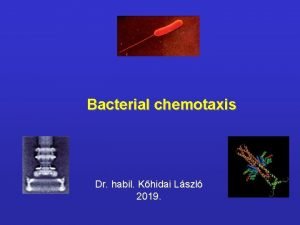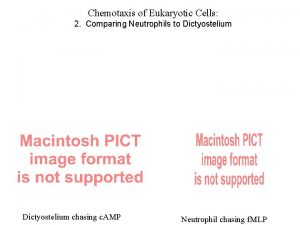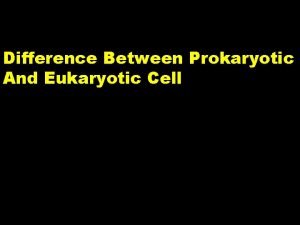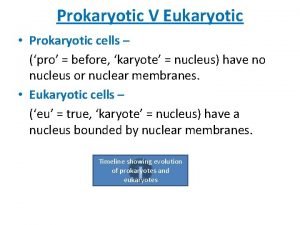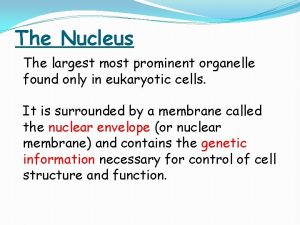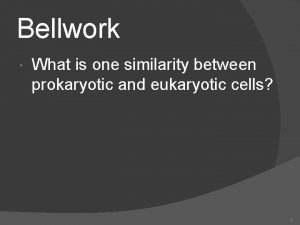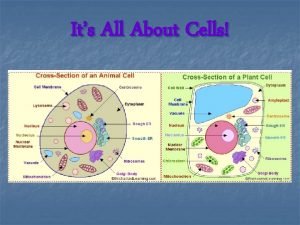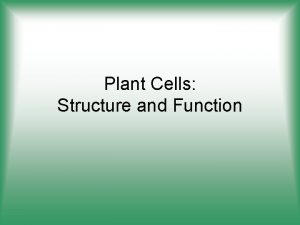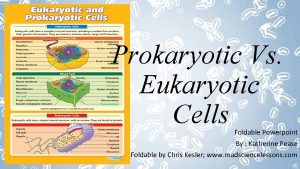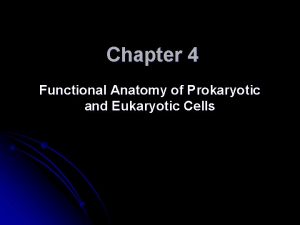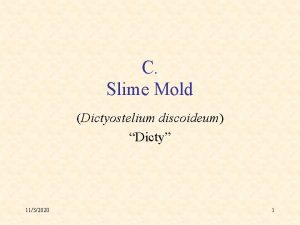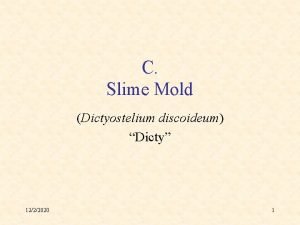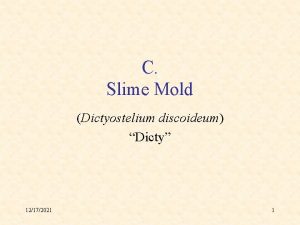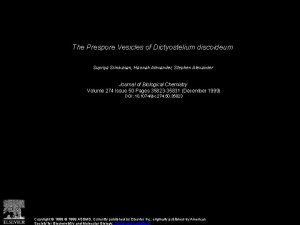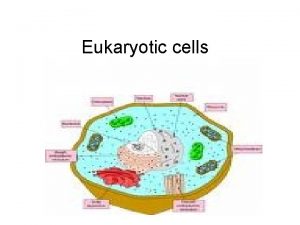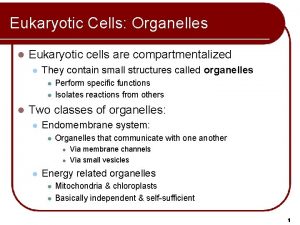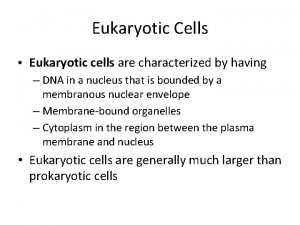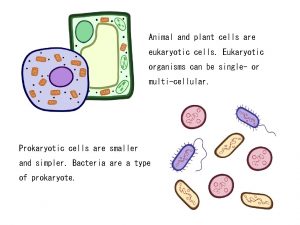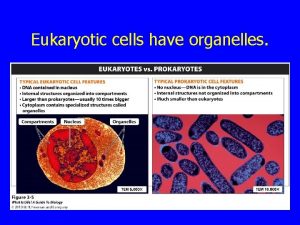Chemotaxis of Eukaryotic Cells 1 Dictyostelium discoideum 2

















- Slides: 17

Chemotaxis of Eukaryotic Cells: 1. Dictyostelium discoideum 2. http: //dictybase. org/Multimedia/index. html http: //dictybase. org/Multimedia/development. html

Life Cycle of Dictyostelium discoideum Lodish, Darnell and Baltimore Molecular Biology of the Cell

1. At high density and low nutrient availability, a random cell begins to release c. AMP. 4. The cycle continues as the next set of cells chemotax toward the center of mass of cells and in turn release c. AMP after a lag, recruiting yet more cells 2. Adjacent cells chemotaxis up the c. AMP gradient and the phosphodiesterase they release degrades the c. AMP. 3. After a lag, the chemotaxing cells release their own c. AMP. This creates a a second, greater c. AMP gradient.

Phosphoinositide 3 -kinase (PI 3 K) is an enzyme found in all multicellular eukaryotic organisms. In response to cell stimulation it is activated and places a phosphate at the 3 position of the inositol ring of phosphatidylinositol-4, 5 bisphosphate (PIP 2) to generate phosphatidylinositol-3, 4, 5 -trisphosphate (PI 3, 4, 5 -P 3 or PIP 3). PIP 2 is at high concentrations at the plasma membrane of all eukaryotic cells and only a small fraction of this lipid is converted to PI-3, 4, 5 P 3 in response to cell stimulation. PI PI 4 K PI 4 P 5 K PI-4 -P PI 3 K PI-3, 4, 5 -P 3 PI-4, 5 -P 2 O Fatty Acid C O O O O PI-3, 4, 5 -P 3 P O O 1 O 6 5 2 O O OH OH P O O 3 4 O O P O O

Outside c. AMP PIP 2 Receptor PIP 2 Gbg Ga Ga PIP 2 ? ? PI 3 K PIP 33 PIP PH PIP 2 PTEN ? ? Recruitment of cortical actin to drive cell polarization and motility Adenylyl Cyclase c. AMP (secreted) PIP 3 PH Cytosol

A green fluorescent protein chimera of a pleckstrin homology (PH) domain that binds to the lipid phosphatidylinositol-3, 4, 5 trisphosphate (PIP 3) reveals that this lipid is generated at the leading edge of the cell in a dynamic fashion that rapidly responds to changes in the extracellular c. AMP gradient. (from Richard Firtel)

A mutation in the PH domain that prevents binding to PI-3, 4, 5 -P 3 prevents recruitment to the membrane (Richard Firtel)

From Richard Firtel

Local Excitation, Global Inhibition (LEGI) Model Ma et al. , 2004 Biophysical J. 87, 3764 Assumptions: PI 3 K LEGI 1. Receptor occupation rapidly stimulates a local, membrane imbedded (slowly diffusable) component that activates a membrane imbedded PI 3 K binding protein. 2. This recruits PI 3 K from the cytosol to the membrane and results in local production of PIP 3. 3. Receptor occupation also stimulates a cytosolic component that diffuses throughout the cell and globally inactivates the membrane imbedded PI 3 K binding protein. 4. The activation of the global inhibitor is slower than activation of the local activator. 5. Thus, PI 3 K is concentrated near activated receptors

Local Excitation, Global Inhibition (LEGI) Model Ma et al. , 2004 Biophysical J. 87, 3764 Assumptions: PTEN Regulation 1. Receptor occupation rapidly stimulates a local, membrane imbedded (slowly diffusable) component that inactivates a membrane imbedded PTEN binding protein. 2. This locally releases PTEN from the membrane and allows local production of PIP 3. 3. Receptor occupation also stimulates a cytosolic component that diffuses throughout the cell and globally activates the membrane imbedded PTEN binding protein. 4. The activation of the global PTEN regulator is slower than activation of the local regulator. 5. Thus, PTEN levels are reduced near activated receptors and elevated elsewhere. Note: PTEN regulation and PI 3 K regulation are assumed to be uncoupled

L PI 3 K half of the LEGI model L R BS S EA E BSA PI 3 K Membrane BS I BSA IA IA PI 3 K Cytosolic PI 3 K, I and IA are freely diffusable throughout the cytosol. Membrane imbedded components (R, S, E, BS) have more restricted movement

Virtual Cell Model Ma et al. (Devreotes & Iglesias) Using Lowe and Schaff, 2001, Trends Biotechnol. 19, 401; Virtual Cell http: //www. nrcam. uchc. edu/applications. html

Virtual Cell Model Ma et al. (Devreotes & Iglesias)

Virtual Cell Model Ma et al. (Devreotes & Iglesias)

Virtual Cell Model Ma et al. (Devreotes & Iglesias)

Virtual Cell Model Ma et al. (Devreotes & Iglesias) The PIP 3 gradient depends on the c. AMP gradient but is relatively insensitive to the absolute amount of c. AMP, allowing adaptation to higher basal c. AMP

Virtual Cell Model Ma et al. (Devreotes & Iglesias)
 Prokaryotic cell
Prokaryotic cell Cuál es la diferencia entre la célula animal y vegetal
Cuál es la diferencia entre la célula animal y vegetal Which organisms are prokaryotes
Which organisms are prokaryotes Eukaryotic vs prokaryotic cell
Eukaryotic vs prokaryotic cell Khidai
Khidai Chemotaxis
Chemotaxis Chemotaxis
Chemotaxis Chemotaxis
Chemotaxis Differences between prokaryotic and eukaryotic cells
Differences between prokaryotic and eukaryotic cells Differences between prokaryotic and eukaryotic cells
Differences between prokaryotic and eukaryotic cells Diff between prokaryotic and eukaryotic cells
Diff between prokaryotic and eukaryotic cells Most prominent organelle in eukaryotic cells
Most prominent organelle in eukaryotic cells Linear chromosomes in eukaryotes
Linear chromosomes in eukaryotes Similarity between prokaryotic and eukaryotic cells
Similarity between prokaryotic and eukaryotic cells Are prokaryotic cells living or nonliving
Are prokaryotic cells living or nonliving Eukaryotic plant
Eukaryotic plant Eukaryotic cells
Eukaryotic cells Functional anatomy of prokaryotic and eukaryotic cells
Functional anatomy of prokaryotic and eukaryotic cells




